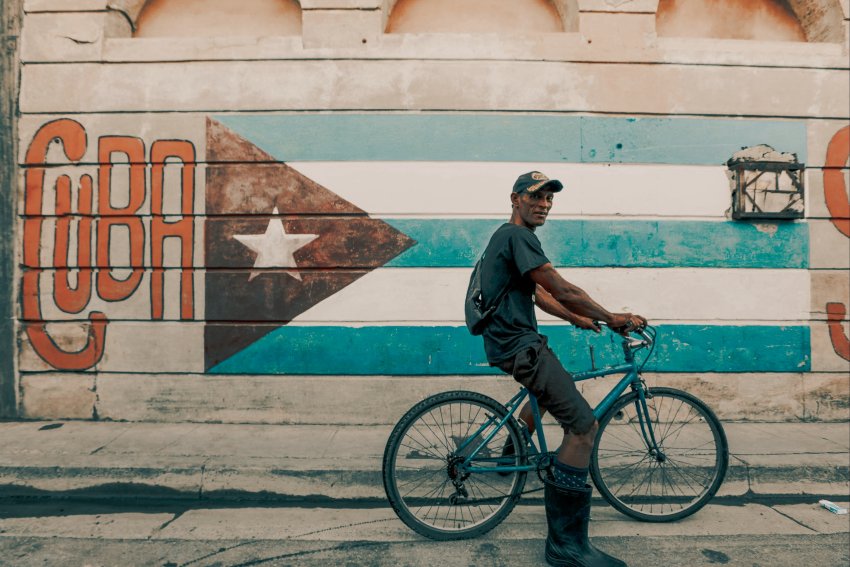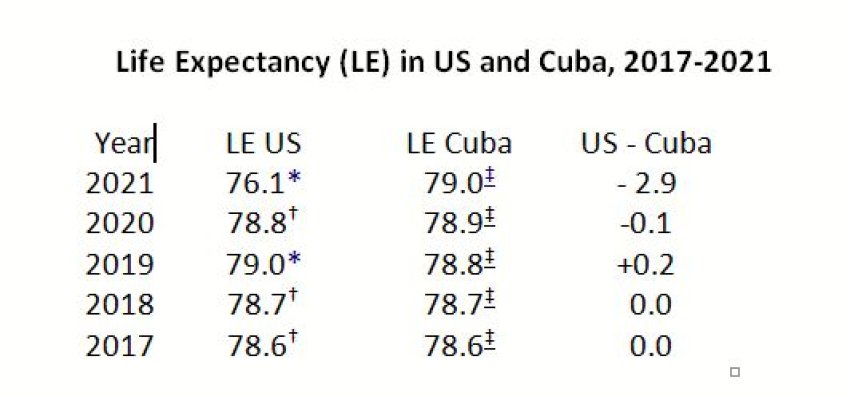
Recent data shows that between 2019 and 2021, life expectancy in the United States plunged almost three years while for Cuba it edged up 0.2 years. Yet, in 1960, the year after its revolution, Cuba had a life expectancy of 64.2 years, lower by 5.6 years than that in the US (69.8 years).
As I document in Cuban Health Care, the island quickly caught up to the US and, from 1970 through 2016, the two countries were neck and neck, with some years Cuba and other years the US, having a longer life expectancy. But neither country was ever as much as one year of life expectancy ahead of the other.
This continued through the beginning of the COVID-19 outbreak, which sharply changed the pattern. Life expectancy in the US suddenly dropped behind that in Cuba. Bernd Debusmann Jnr of BBC News wrote that life expectancy in the US fell “to the lowest level seen since 1996”.
“Government data showed life expectancy at birth now stands at 76.1 compared to 79 in 2019. That is the steepest two-year decline in a century.” From 2019 to 2020, “LE declined in all 50 states and the District of Columbia.”
How could a country with all the problems of Cuba, have a life expectancy almost three years greater than the US?
The COVID-19 contrast
US Centers for Disease Control and Prevention data confirmed that “COVID was the main contributing factor [to changes in life expectancy]. Between 2019 and 2020, the pandemic contributed to 74% of the decline.”
A critical divergence is that Cuba guarantees health care to all as a human right while the US system is based on profit and political grandstanding. When COVID-19 hit, the US dawdled for months as Cuba mobilised for medical action.
The Ministry of Health developed a national strategy before the island’s first victim had succumbed to the disease. Cuban TV carried daily press conferences with detailed info on the status of new patients, results of cabinet meetings on COVID, and announcing the best way for citizens to protect themselves and others. Social distancing, masks and contact tracing were universally accepted.
Each day Cuban medical students knocked on doors to ask citizens how they were. Students’ tasks included obtaining survey data from residents and making extra visits to the elderly, infants and those with respiratory problems. Medical data was used by those in the highest decision-making positions of the country. Every Cuban citizen and every health care worker, from those at neighbourhood doctor's offices through those at research institutes, had a part in determining health policy.
This inclusive approach resulted in Cuba’s having 87 COVID deaths by July 21, 2020, when the US had experienced 140,300. While the US population is 30 times that of Cuba, it had 1613 times as many deaths.
Racial divide
News stories also mentioned other factors associated with the shorter life expectancy in the US: drug overdoses, heart disease, chronic liver disease, cirrhosis and suicides. The corporate press acknowledged racial disparities.
There had been progress in reducing life expectancy differences between Black and white Americans. This was reversed during 2018–20 when life expectancy went down 1.36 years for whites, 3.25 years for Hispanics, and 3.88 years for Blacks.
The fall in US life expectancy was even more pronounced among Native Americans and Alaska Natives. Since 2019, it “dropped by 6.6 years, more than twice that of the wider US population”.
The US has multiple groups who reject government attempts to vaccinate or wear masks. Most loud-mouthed, of course, are the right wingers who lividly despise the very idea of public health campaigns. While their thought processes are hallucination-based, people of color have reality-based fears of being ignored, lied to, and used for government experimentation, such as the Tuskegee Syphilis Study.
Factors ignored
Among factors with increasing US COVID-19 rates ignored by the corporate media in the US are: poverty, misinformation, abortion, the embargo against Cuba and preparation for climate change.
Poverty. The first tasks of the Cuban revolution were to simultaneously address poverty, food, sanitation, literacy, education, racism and housing, which the rebels saw as parts of a unitary whole. During the COVID-19 crisis, many US corporations were determined to force low-wage workers to stay at their jobs, spreading the disease. Cuba told those with COVID-19 to stay home.
Misinformation. Discussions of COVID-19 deaths must not ignore the deadly role of science denial. At the same time as Donald Trump was foolishly downplaying the mounting danger of COVID-19, Cuba was far along developing its “Novel Coronavirus Plan for Prevention and Control”. Trump was not and is not an isolated individual — he manifests a life-threatening movement toward lunacy.
Abortion. Cuba also does not have a “Women’s Lives Don’t Matter!” movement seeking to eliminate abortion rights. Those who do not want an abortion do not get one and people do not seek to impose their religious beliefs on others. The Supreme Court’s allowing states to criminalise abortion will cause many women to die, from self-attempts at abortion and lack of its availability.
Embargo. The “embargo” has a special relationship with life expectancy in Cuba: one might expect it to decrease life expectancy; but it has not done so. When Cuba was reeling from the 1991 fall of the Soviet Union, the US passed laws intending to punish those who continued to trade with it. Yet, due to its prioritising health care during the 1990s, Cuba’s infant mortality decreased while its life expectancy showed a slight increase.
International solidarity movements have stepped in to help Cuba overcome many embargo effects. Lack of essential materials prevented Cuba from performing liver transplants on children. But, during May 2022, Puentes de Amor (Bridges of Love) delivered the vital chemical compound to the William Soler Pediatric Hospital.
Resilience. In March 2022 Scientific American editors wrote that the most important part of preparing for the next pandemic is “building new systems”. Unfortunately, this is what the US avoids as it becomes absorbed in making minor tweaks to outmoded, inadequate systems of environmental protection.
Cuba has been holding Bastión (bulwark) events involving as many as four million citizens who carry out food production, disease control, sanitation and safeguarding medical supplies. When a policy change is introduced, government representatives go to each community, including the most remote rural ones, to make sure that everyone knows the threats that climate change poses to their lives and how they can alter behaviours to minimise them.
Cuba also employs agroecology, biodigesters and vastly expanded vegetable production. This is why Jason Hickel’s “Sustainable Development Index” rated Cuba’s ecological efficiency as the best in the world in 2019.
Where are we headed?
By 2017, Cuba had become the only country with a government-led plan (Project Life, or Tarea Vida) to combat climate change, which includes a 100-year projection. While Cuba is looking ahead and planning how to protect people from increasingly devastating storms, US politicians feverishly bury their heads in the sand.
This causes life expectancy in the US to plunge while life expectancy in Cuba climbs slowly upward. COVID-19 did not create the life expectancy divide between the US and Cuba. COVID-19 exacerbated trends that have become increasingly intertwined for decades.
[Don Fitz (fitzdon@aol.com) is on the Editorial Board of Green Social Thought, where a version of this article originally appeared. He was the 2016 candidate of the Missouri Green Party for Governor. His book, Cuban Health Care: The Ongoing Revolution, has been available since June 2020.]
